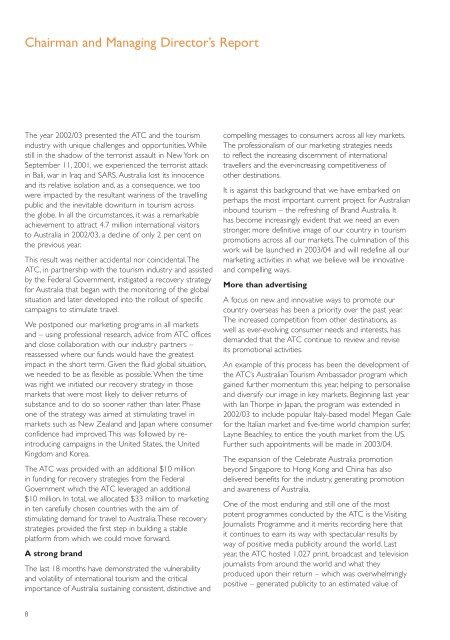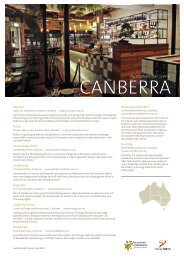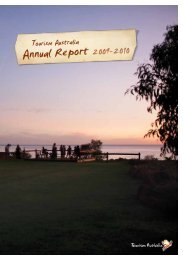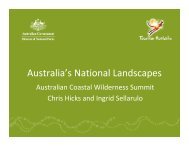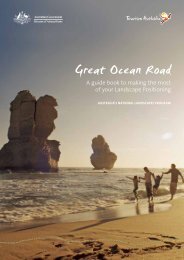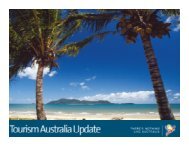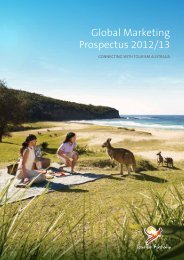2002 - 2003 Annual Report - Tourism Australia
2002 - 2003 Annual Report - Tourism Australia
2002 - 2003 Annual Report - Tourism Australia
Create successful ePaper yourself
Turn your PDF publications into a flip-book with our unique Google optimized e-Paper software.
Chairman and Managing Director’s <strong>Report</strong><br />
The year <strong>2002</strong>/03 presented the ATC and the tourism<br />
industry with unique challenges and opportunities. While<br />
still in the shadow of the terrorist assault in New York on<br />
September 11, 2001, we experienced the terrorist attack<br />
in Bali, war in Iraq and SARS. <strong>Australia</strong> lost its innocence<br />
and its relative isolation and, as a consequence, we too<br />
were impacted by the resultant wariness of the travelling<br />
public and the inevitable downturn in tourism across<br />
the globe. In all the circumstances, it was a remarkable<br />
achievement to attract 4.7 million international visitors<br />
to <strong>Australia</strong> in <strong>2002</strong>/03, a decline of only 2 per cent on<br />
the previous year.<br />
This result was neither accidental nor coincidental.The<br />
ATC, in partnership with the tourism industry and assisted<br />
by the Federal Government, instigated a recovery strategy<br />
for <strong>Australia</strong> that began with the monitoring of the global<br />
situation and later developed into the rollout of specific<br />
campaigns to stimulate travel.<br />
We postponed our marketing programs in all markets<br />
and – using professional research, advice from ATC offices<br />
and close collaboration with our industry partners –<br />
reassessed where our funds would have the greatest<br />
impact in the short term. Given the fluid global situation,<br />
we needed to be as flexible as possible. When the time<br />
was right we initiated our recovery strategy in those<br />
markets that were most likely to deliver returns of<br />
substance and to do so sooner rather than later. Phase<br />
one of the strategy was aimed at stimulating travel in<br />
markets such as New Zealand and Japan where consumer<br />
confidence had improved.This was followed by reintroducing<br />
campaigns in the United States, the United<br />
Kingdom and Korea.<br />
The ATC was provided with an additional $10 million<br />
in funding for recovery strategies from the Federal<br />
Government which the ATC leveraged an additional<br />
$10 million. In total, we allocated $33 million to marketing<br />
in ten carefully chosen countries with the aim of<br />
stimulating demand for travel to <strong>Australia</strong>.These recovery<br />
strategies provided the first step in building a stable<br />
platform from which we could move forward.<br />
A strong brand<br />
The last 18 months have demonstrated the vulnerability<br />
and volatility of international tourism and the critical<br />
importance of <strong>Australia</strong> sustaining consistent, distinctive and<br />
compelling messages to consumers across all key markets.<br />
The professionalism of our marketing strategies needs<br />
to reflect the increasing discernment of international<br />
travellers and the ever-increasing competitiveness of<br />
other destinations.<br />
It is against this background that we have embarked on<br />
perhaps the most important current project for <strong>Australia</strong>n<br />
inbound tourism – the refreshing of Brand <strong>Australia</strong>. It<br />
has become increasingly evident that we need an even<br />
stronger, more definitive image of our country in tourism<br />
promotions across all our markets.The culmination of this<br />
work will be launched in <strong>2003</strong>/04 and will redefine all our<br />
marketing activities in what we believe will be innovative<br />
and compelling ways.<br />
More than advertising<br />
A focus on new and innovative ways to promote our<br />
country overseas has been a priority over the past year.<br />
The increased competition from other destinations, as<br />
well as ever-evolving consumer needs and interests, has<br />
demanded that the ATC continue to review and revise<br />
its promotional activities.<br />
An example of this process has been the development of<br />
the ATC’s <strong>Australia</strong>n <strong>Tourism</strong> Ambassador program which<br />
gained further momentum this year, helping to personalise<br />
and diversify our image in key markets. Beginning last year<br />
with Ian Thorpe in Japan, the program was extended in<br />
<strong>2002</strong>/03 to include popular Italy-based model Megan Gale<br />
for the Italian market and five-time world champion surfer,<br />
Layne Beachley, to entice the youth market from the US.<br />
Further such appointments will be made in <strong>2003</strong>/04.<br />
The expansion of the Celebrate <strong>Australia</strong> promotion<br />
beyond Singapore to Hong Kong and China has also<br />
delivered benefits for the industry, generating promotion<br />
and awareness of <strong>Australia</strong>.<br />
One of the most enduring and still one of the most<br />
potent programmes conducted by the ATC is the Visiting<br />
Journalists Programme and it merits recording here that<br />
it continues to earn its way with spectacular results by<br />
way of positive media publicity around the world. Last<br />
year, the ATC hosted 1,027 print, broadcast and television<br />
journalists from around the world and what they<br />
produced upon their return – which was overwhelmingly<br />
positive – generated publicity to an estimated value of<br />
8


